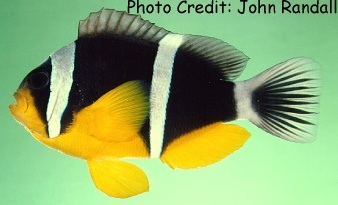
By Bob Goemans


Likely Reef Tank Suitable
Likely Fish-Only Tank Suitable
These fishes belong in the Order Perciformes and Suborder Labroidei as members of the Family Pomacentridae (Damselfishes) where they fall into the Subfamily Amphiprioninae (Anemonefishes). They are one of the more colorful, hardy, small, mostly peaceful, and inexpensive marine fishes. In the wild they are found closely associated with anemones, where they form a commensal relationship.
There are 28 species of Anemonefish with the Maroon female Clownfish Premnas biaculeatus being the largest at 6.5 inch (17 cm) and Amphiprion thiellei being the smallest at 3.5 inch (9 cm). Most are found along coastal protected reefs, generally in shallow waters and usually in small groups near their favorite anemone. Their natural diet consists mainly of zooplankton, and they are generally easily maintained in the aquarium. They accept a wide variety of foodstuffs and most do well in a temperature range of 77 - 82 F (25 - 27 C), unless noted differently.
Family members fall into six groups called "Complexes." The Percula Complex consists of A. percula and A. ocellaris. The Tomato Complex consists of A. ephippium, A. frenatus, A. mccullochi, A. melanopus, and A. rubrocinctus. The Skunk Complex consists of A. akallopisos, A. leucokranos, A. nigripes, A. perideraion, A. sandaracinos, and A. thiellei. The Clarkii Complex consists of A. akindynos, A. allardi, A. bicinctus, A. clarkii, A. chagosensis, A. chrysogaster, A. chrysopterus, A. fuscocaudatus, A. latifasciatus, A. omanensis, and A. tricinctus. The Saddleback Complex consists of A. latezonatus, A. polymnus, and A. sebae. And finally, the Maroon Complex with its single member, Premnas biaculeatus.
Color patterns between juveniles and sub-adults of the same species are often similar. A. melanopus and A. frenatus juveniles are almost identical. Other species, such as A. akindynos, A. clarkii and A. chrysopterus also have similar sub-adult patterns. Yet, A. percula and A. ocellaris juveniles and sub-adults are very similar to the adult color patterns. Most all other anemonefishes have vast differences between growth stages. It should be noted some aquarists find it difficult to tell the difference between A. percula and A. ocellaris. Both look quite similar except that A. percula has more distinct black borders on its white stripes. It also has a slightly higher dorsal fin.
Generally, its advantageous to place "all" clownfish into the aquarium at one time, i.e., not one this month and another the following month. The first group of clownfishes into the aquarium will head straight for their favorite anemone, if available, and soon make it their home. Any clownfish added at a later date may be chased away by its present inhabitants, and/or be severely injured in a territory dispute!
If anemonefish will be in your aquarium, I highly recommend reading "Field Guide to Anemonefishes and their Host Anemones" by Daphne G. Fautin and Gerald R. Allen, and "Clownfishes, A Guide to Their Captive Care, Breeding & Natural History" by Joyce D. Wilkerson. A book review of that work can be seen on this website on my Product & Book Review page.